How Membrane Layer Switches Add To the Toughness of Electronic Control Panels
Membrane buttons play an essential role in improving the toughness of digital control panels, largely through their multi-layered building and construction which supplies efficient defense against environmental elements such as wetness and dust. The lack of moving parts considerably decreases the probability of mechanical failures, making membrane switches over ideal for demanding applications.
Interpretation of Membrane Buttons

Membrane switches are developed to be thin and light-weight, making them appropriate for applications where space is limited. They can be made in different shapes, sizes, and colors, supplying adaptability in style that satisfies visual and functional needs. Furthermore, membrane buttons can integrate numerous modern technologies, such as responsive comments and LED indications, boosting customer experience.
Because of their building, membrane switches are typically resistant to dust, moisture, and basic wear, adding to their durability sought after settings. Their seamless style not just promotes simple cleaning yet likewise decreases the danger of mechanical failing, making them a favored option for makers seeking reliable individual interfaces in their electronic control board.
Security Versus Environmental Variables
The layout of membrane changes naturally supplies a degree of security versus different ecological variables, which is important for keeping performance in challenging problems - Membrane Switch. These switches are generally built with layers of flexible materials that secure inner components from dampness, dust, and contaminants. By enveloping the circuitry, membrane switches over lessen the risk of short circuits and deterioration, which can considerably hinder performance
In addition, the use of durable adhesives and sealants during production enhances their resistance to environmental obstacles. Membrane layer switches can withstand exposure to chemicals and solvents, making them ideal for markets such as food processing and medical care, where hygiene and sanitation are extremely important. Their smooth surface layout also prevents the buildup of dust and bacteria, helping with much easier cleaning and upkeep.
Temperature level variations are one more ecological issue, and membrane layer buttons are engineered to function successfully throughout a wide variety of temperatures (Membrane Switch). This flexibility makes certain that control panels stay operational in various setups, from commercial environments to customer electronic devices
Effect On User Interaction
Individual interaction with digital control board is considerably affected by the design and functionality of membrane layer switches. These buttons give a responsive interface that enhances the total customer experience, allowing for see this instinctive navigating and control. Their receptive nature guarantees that customers receive immediate feedback upon activation, which is essential for jobs requiring accuracy and performance.
Additionally, the smooth surface of membrane layer switches over assists in very easy cleansing and maintenance, advertising user self-confidence in the reliability of the interface. This sanitation is especially vital in atmospheres where hygiene is paramount, such as medical or food handling settings. Furthermore, the portable and light-weight layout of membrane changes adds to the aesthetic charm of control panels, urging user interaction through a modern-day and streamlined appearance.
Additionally, the combination of aesthetic aspects, such as published icons and backlighting, helps users promptly determine functions, reducing the discovering contour connected with brand-new equipment. Because of this, users can run devices better, resulting in increased productivity and contentment. try this site In recap, membrane switches play an essential role in boosting user interaction by combining functionality, appearances, and simplicity of usage, ultimately leading to boosted operational effectiveness.
Layout Versatility and Personalization
Style adaptability and personalization are important facets of membrane switches, making it possible for producers to customize electronic control panels to particular applications and user requirements. This versatility permits the integration of numerous design components, such as shades, graphics, and structures, which can boost the aesthetic appeal and user involvement of the control board.
Membrane switches can be personalized in shapes and size, accommodating a wide visit their website variety of devices and applications, from industrial equipment to consumer electronic devices. This convenience ensures that makers can produce instinctive interfaces that straighten with individual expectations and functional needs. Additionally, the capability to integrate distinct functions such as backlighting or responsive responses additionally boosts use, enabling a much more interactive experience.
Additionally, the production procedure for membrane changes sustains the fast prototyping of styles, allowing producers to iterate and refine their principles quickly. This capacity not only increases the growth timeline but additionally makes certain that the end product satisfies particular functional and aesthetic standards.

Cost-Effectiveness and Long Life
Cost-effectiveness and longevity are substantial advantages of membrane switches, making them an appealing choice for producers and end-users alike. These switches are generally cheaper to generate than typical mechanical buttons, mainly due to their simplified production procedures and the decreased variety of elements required. This price advantage expands not only to first manufacturing however additionally to long-lasting functional expenditures, as membrane layer buttons often require much less upkeep and have a reduced failing rate.
In addition, the long life of membrane layer switches adds to their overall worth. Built from resilient products, they are immune to ecological factors such as dampness, dust, and chemicals, which can result in early wear in various other button types. The lack of relocating parts lessens mechanical failing, enabling membrane switches over to preserve capability over expanded periods.
This durability is especially useful in applications requiring consistent performance under demanding problems, such as clinical gadgets and commercial tools. Eventually, the combination of cost-effectiveness and longevity makes membrane switches over an economically sensible option for makers, supplying dependable options that stand up to the test of time while enhancing budgetary factors to consider.
Verdict
In conclusion, membrane switches substantially enhance the sturdiness of digital control panels via their durable building and protective functions - Membrane Switch. Generally, membrane layer changes represent a trustworthy and cost-efficient option for boosting the long life and performance of electronic control systems.